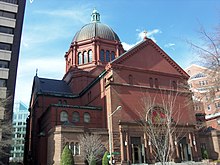Cathedral of St. Matthew the Apostle
| Cathedral of St. Matthew the Apostle | |
|---|---|
 |
|
| 38°54′22″N 77°2′24″W / 38.90611°N 77.04000°WCoordinates: 38°54′22″N 77°2′24″W / 38.90611°N 77.04000°W | |
| Location | 1725 Rhode Island Avenue NW Washington, D.C. |
| Country | United States |
| Denomination | Catholic |
| Website | stmatthewscathedral.org |
| History | |
| Founded | 1840, 177 years ago |
| Architecture | |
| Architect(s) | C. Grant La Farge |
| Style |
Renaissance Revival Romanesque Revival |
| Completed | 1913 |
| Specifications | |
| Capacity | 1,000 sitting |
| Length | 155 feet (47 m) |
| Width | 136 feet (41 m) |
| Height | 200 feet (61 m) |
| Number of domes | One |
| Dome height (outer) | 190 feet (58 m) |
| Administration | |
| Archdiocese | Archdiocese of Washington |
| Clergy | |
| Archbishop | Cardinal Donald Wuerl |
| Rector | Msgr. W. Ronald Jameson |
|
St. Matthew's Cathedral and Rectory
|
|
| NRHP Reference # | 74002173 |
| Added to NRHP | January 24, 1974 |
The Cathedral of St. Matthew the Apostle in Washington D.C., most commonly known as St. Matthew's Cathedral, is the seat of the Archbishop (currently Donald Cardinal Wuerl) of the Roman Catholic Archdiocese of Washington. As St. Matthew's Cathedral and Rectory, it was listed on the National Register of Historic Places in 1974.
The cathedral is in downtown Washington at 1725 Rhode Island Avenue NW between Connecticut Avenue and 17th Street. The closest Metrorail station is Farragut North, on the Red Line. It is seven blocks north and a two blocks west of the White House.
St. Matthew's is dedicated to the Apostle Matthew, who among other things is patron saint of civil servants, having himself been a tax collector. It was established 177 years ago in 1840 as the fourth Catholic parish in the District of Columbia. Originally located at 15th and H Streets, construction of the current church began in 1893, with the first Mass being celebrated June 2, 1895. Construction continued until 1913 when the church was dedicated. In 1939, it became the cathedral for the newly established Archdiocese of Washington.
The structure is constructed of red brick with sandstone and terra cotta trim in the Romanesque Revival style with Byzantine elements. Designed by architect C. Grant La Farge, it is in the shape of a Latin cross measuring 155 ft × 136 ft (47 m × 41 m) and seats about 1,200 persons. The interior is richly decorated in marble and semiprecious stones, notably a 35 ft (11 m) mosaic of Matthew behind the main altar by Edwin Blashfield. The cathedral is capped by an octagonal dome that extends 190 ft (58 m) above the nave and is capped by a cupola and crucifix that brings the total height to 200 ft (61 m). Both structural and decorative elements underwent extensive restoration between 2000 and September 21, 2003, the Feast day of St. Matthew.
...
Wikipedia

